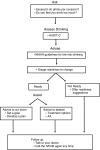Interactive voice response technology can deliver alcohol screening and brief intervention in primary care
- PMID: 20127196
- PMCID: PMC2842550
- DOI: 10.1007/s11606-009-1233-0
Interactive voice response technology can deliver alcohol screening and brief intervention in primary care
Abstract
Background: Alcohol screening and brief intervention (BI) is an effective primary care preventive service, but implementation rates are low. Automating BI using interactive voice response (IVR) may be an efficient way to expand patient access to needed information and advice.
Objective: To develop IVR-based BI and pilot test it for feasibility and acceptability.
Design: Single-group pre-post feasibility study.
Participants: Primary care patients presenting for an office visit.
Interventions: IVR-BI structured to correspond to the provider BI method recommended by NIAAA: (1) Ask about use; (2) Assess problems; (3) Advise and Assist for change, and (4) Follow up for continued support. Advice was tailored to patient readiness and preferences.
Measurements: Utilization rate, call duration, and patients' subjective reports of usefulness, comfort and honesty with the IVR-BI. Pre-post evaluation of motivation to change and change in alcohol consumption as measured by Timeline Follow Back.
Results: Call duration ranged from 3-7 minutes. Subjective reactions were generally positive or neutral. About 40% of subjects indicated IVR-BI had motivated them to change. About half of the patients had discussed drinking with their provider at the visit. These tended to be heavier drinkers with greater concerns about drinking. Patients who reported a provider-delivered BI and called the IVR-BI endorsed greater comfort and honesty with the IVR-BI. On average, a 25% reduction in alcohol use was reported two weeks after the clinic visit.
Conclusions: Using IVR technology to deliver BI in a primary care setting is feasible and data suggest potential for efficacy in a larger trial.
Figures
References
-
- US Preventive Services Task Force Screening and behavioral counseling interventions in primary care to reduce alcohol misuse: recommendation statement. Ann Intern Med. 2004;140(7):554–556. - PubMed
-
- Fleming MF, Mundt MP, French MT, Manwell LB, Stauffacher EA, Barry KL. Brief physician advice for problem drinkers: long-term efficacy and benefit-cost analysis. Alcohol Clin Exp Res. 2002;26(1):36–43. - PubMed
-
- Kaner EF, Beyer F, Dickinson HO, et al. Effectiveness of brief alcohol interventions in primary care populations. [Review] [93 refs]. Cochrane Database Syst Rev. 2007;(2):CD004148. - PubMed
Publication types
MeSH terms
Grants and funding
LinkOut - more resources
Full Text Sources
Medical
Miscellaneous


